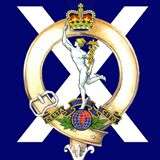32 Signal Regiment
| 32nd Signal Regiment | |
|---|---|
 Emblem for 32nd Signal Regiment | |
| Active | 1967 - Present |
| Country |
|
| Branch |
|
| Type | Royal Corps of Signals |
| Role |
National Resilience Communications Regional RPOC Support |
| Size | Four squadrons |
| Part of | 1st (UK) Signal Brigade |
| Garrison/HQ |
RHQ 32 Signal Regiment - Glasgow 2 (City of Dundee and Highland) Signal Squadron - Dundee & Aberdeen 40 (North Irish Horse) Signal Squadron - Belfast 52 (Support) Support Squadron - Glasgow 51 (Scottish) Squadron - Edinburgh & East Kilbride |
| Motto(s) | Certa Cito (“Swift and Sure”) |
| Colors | Sky Blue, Navy and Green (Air, Sea and Land) |
| March |
Quick - Begone Dull Care Slow - H.R.H. (Princess Royal) |
| Mascot(s) | Mercury (“Jimmy”) |
| Commanders | |
| Current commander | Lt Col R Jones R Signals |
| Insignia | |
| Tactical Recognition Flash |
 |
| Tartan |
.png) |
The 32nd Signal Regiment is a British Army Reserve Regiment of the Royal Corps of Signals. The regiment forms part of 1st (UK) Signal Brigade, providing military communications for national operations.
History
Early history
The 1st Lanarkshire Voluntary Military Engineers were raised in Glasgow on 5 December 1859 as part of the Volunteer Force.[1] The 2nd Lanarkshire Voluntary Military Engineers and 3rd Lanarkshire Voluntary Military Engineers were raised in 1860 and 1862 respectively.[1] The regiment was formally registered with the War Office on 27 February 1860. In 1863 the regiment adopted the uniform of the Royal Engineers. In 1864 the "Corps Training Ground" was established in Maryhill. In 1894 the Telegraph Company, 2nd Lanarkshire Volunteer Military Engineers was added to the regiment.[2] In 1900 the regiment was chosen to be part of the first operational use of the Volunteer Force and a company of two officers and 99 Other Ranks were sent to the Second Boer War.[1]
First World War
As part of the 1908 Haldane Reforms, which created the TA, the regiment became the Lowland Divisional Telegraph Company.[2] A Wireless, Cable and Airline Company were added and the regiment was established as a Field Company to support 51st (Highland) Division. After the outbreak of World War I in 1914 the Glasgow Group RE was disbanded and the regiment was sent as part of IV Corps and the British Expeditionary Force to France.[1]
Second World War
On reforming the Territorial Army in 1920, 52nd Lowland Division Signal Company reformed at Maryhill. On 28 June that year the Royal Corps of Signals was formed and the regiment changed uniform and cap badge. During World War II the regiment again saw active service in support of both 51st (Highland) Division and 52nd Lowland Divisions in the European theatre. On reforming the TA in 1947, the regiment returned once again to Maryhill as the 51st/52nd (Scottish) Infantry Division Signal Regiment.[2] The regiment was retitled 52nd Lowland Infantry Division Signal Regiment in 1948.[2]
Post War
As a result of the 1966 Defence White Paper, a major reorganisation of the Army took place, caused by the end of National Service, with the TA being disbanded and the Territorial Army Volunteer Reserve (TAVR) formed. Instead of forming large reserve formations, the role of the new TAVR was to provide individual and unit-sized reinforcements for the Regular Army. The 32nd (Scottish) Signal Regiment was created as a TAVR II being formed on 1 April 1967. The new regiment was composed of five squadrons, amalgamating the four Signals Regiments in Scotland. They were:[3]
- Headquarters Squadron
- 51st (Highland) Signal Squadron - successor to 51 (Highland) Signal Regiment
- 52nd (Lowland) Signal Squadron - successor to 52 (Lowland) Signal Regiment
- 61st (City of Edinburgh) Signal Squadron - successor to 61 (City of Edinburgh) Signal Regiment
- 82nd (Army Emergency Reserve) Signal Squadron - successor to 82 Signal Regiment (Army Emergency Reserve)
The regiment gained a sixth squadron in 1969, when a Squadron of North Irish Horse became 69 (North Irish Horse) Signal Squadron.[3] The regiment was reduced to five squadrons in the early 1970s upon the disbandment of 82 Squadron.[3] Due to Options for Change, 69 Squadron transferred to 40 (Ulster) Signal Regiment in 1995.[3]
In October 2010 69 (North Irish Horse) Signal Squadron returned to the Regiment as 40 (North Irish Horse) Signal Squadron.[4] Then under the Army 2020 re-organisation, 2 (City of Dundee and Highland) Squadron was transferred from 38 Signal Regiment.[5]
Structure
The regimental headquarters is situated in North Kelvinside, Glasgow and has five squadrons based in Northern England, Scotland and Northern Ireland:[6]
- 2 (City of Dundee & Highland) Signal Squadron - Dundee & Aberdeen
- 40 (North Irish Horse) Signal Squadron - Belfast
- 50 (Northern) Signal Squadron - Darlington
- 51 (Scottish) Signal Squadron - Edinburgh & East Kilbride
- 52 (Lowland) Support Squadron - Glasgow & York
The regiment is part of 2 Signal Group within 11th Signal Brigade and HQ West Midlands.[7]
References
- 1 2 3 4 Lord and Watson, p. 163
- 1 2 3 4 "Lowland Signals, Royal Corps of Signals". Regiments.org. Retrieved 19 November 2017.
- 1 2 3 4 "32nd (Scottish) Signal Regiment, Royal Corps of Signals". Regiments.org. Retrieved 19 November 2017.
- ↑ "69 (North Irish Horse) Signal Squadron". Signals Badges. Retrieved 19 November 2017.
- ↑ "Summary of Army 2020 Reserves structure and basing changes" (PDF). Ministry of Defence. Retrieved 19 November 2017.
- ↑ "32nd Signal Regiment". Ministry of Defence. Retrieved 19 November 2017.
- ↑ "Army 2020 Report" (PDF). Archived from the original (PDF) on 2014-06-10.
Sources
- Lord, Chris; Watson, Graham (2004). The Royal Corps of Signals: Unit Histories of the Corps (1920-2001) and its Antecedents. Helion. ISBN 978-1874622925.